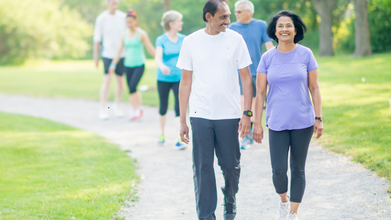- Health Conditions A-Z
- Health & Wellness
- Nutrition
- Fitness
- Health News
- Ayurveda
- Videos
- Medicine A-Z
- Parenting
If You Are Cracking Your Neck Too Much- Here Are 7 Signs You Need To See A Physiotherapist

Image Credits: Canva
Neck cracking can feel satisfying, providing a momentary sense of relief from stiffness and tension. But if you catch yourself cracking your neck excessively, it may be an indicator of an underlying problem that should be treated by a professional. While infrequent neck cracking is not damaging, frequent or violent cracking can lead to joint instability, enhanced stiffness, and even nerve-related problems.
Cracking your neck every so often isn't always bad for you, but if you notice yourself cracking your neck all the time or seeing any of the above warning signs, it's time to make an appointment with a physiotherapist. Treating the underlying cause of your pain using specific treatments will stop long-term damage and get you feeling more comfortable overall. Rather than patching up pain with temporary solutions like neck cracking, turn to professional physiotherapy as an ongoing solution to keeping your neck healthy and free of pain.
A physiotherapist is able to determine if your habit is a benign reaction to pain or an indicator of more profound musculoskeletal issues. Below are seven important signs that indicate it is time to consult a physiotherapist.
1. Repeated Neck Pain or Stiffness
If you’re frequently cracking your neck to relieve tension, but the discomfort keeps returning, it could indicate chronic muscle tightness, poor posture, or an underlying spinal misalignment. Physiotherapists can identify the root cause of your stiffness and provide targeted interventions, such as manual therapy, corrective exercises, and postural adjustments, to restore mobility and reduce discomfort.
2. Reduced Range of Motion
Inability to turn your head side to side or tilt it without pain could indicate limited mobility of your cervical spine. This can be due to muscle imbalances, joint dysfunction, or injury. A physiotherapist can conduct tests for mobility, order certain stretches and strengthening, and teach you to restore full, pain-free range of motion.
3. Numbness or Tingling in Arms and Hands
Numbness or tingling in your arms or hands is a warning sign that cannot be overlooked. Nerve compression or irritation in the cervical spine might be the underlying cause of this symptom, which can be aggravated by habitual neck cracking. Relief from pressure on the involved nerves and restoration of function can be achieved through physiotherapy maneuvers like nerve mobilization exercises, postural corrections, and specific stretching.
4. Frequent Headaches or Migraines
Chronic headaches, especially those that start in the neck (cervicogenic headaches), may be associated with too much neck cracking and muscle strain. Posture, excessive computer or phone screen time, and spinal misalignments can all lead to this type of pain. A physiotherapist can evaluate your posture, suggest ergonomic adjustments, and create a treatment plan to reduce headache causes related to neck problems.
5. Weakness in Your Arms or Hands
If you find you are losing grip strength or have difficulty doing things that need to be done using fine motor function, like typing or picking up objects, then it could be caused by compression of the nerve or dysfunction in the muscle. Physiotherapists will employ strength evaluation and functional exercise to correct muscular imbalance and impairment of the nerves, restoring strength and coordination for you.
6. Cracking Your Neck Multiple Times a Day
If you experience the need to crack your neck every so often during the day, it can be a sign of joint instability or hypermobility. Habitual cracking can result in too much wear and tear on the facet joints over time, which will raise your risk for chronic pain and degenerative conditions such as osteoarthritis. Physiotherapists can give you stabilization exercises to help build up the muscles that support your neck, making frequent adjustments less necessary.
7. Neck Pain After an Injury
If you have been involved in a car accident, fallen, or had any trauma to your neck, ongoing pain should not be dismissed. Whiplash injuries, ligament sprains, or muscle strains may get worse over time if not treated. Physiotherapists can create rehabilitation programs to facilitate healing, restore function, and avoid long-term complications.
Why You Shouldn't Ignore These Signs
Neglecting ongoing neck problems may result in long-term pain, posture issues, and nerve impairment. Physiotherapy provides a non-surgical method of addressing neck pain through enhancing movement, strength, and posture. Professional intervention at an early stage will avoid more complicated problems and decrease reliance on pain-relieving practices such as frequent cracking of the neck.
When to Seek Immediate Medical Attention
Although physiotherapy can be used to control many musculoskeletal disorders, certain symptoms must be treated immediately by a doctor. Medical treatment is indicated if you have:
- Severe headache and neck pain
- Sudden loss of sensation or motor function in the arms
- Dizziness or loss of balance
- Neck pain after a traumatic injury
Run To Heal: How A 56-year-old NYC Teacher Ran To Reverse His Diabetes

Credits: iStock, PEOPLE
A New York City teacher Pedro Soto, 56, who teachers at the Manhattan school had a simple sore throat and he believed it was from a viral infection, but it soon turned out to be type 2 diabetes.
This was in April 2024, when he went to his doctor with the complaint of a sore throat and took a blood test. This is when he was "officially diagnosed with type 2 diabetes".
In an interview with PEOPLE, he tells while the doctor recommended medications for him, he was determined to make a lifestyle change first. "After receiving the news, I chose not to start medication right away. Instead, I committed to exercising, running twice a week and improving my diet."
Turns out, running, changed his life.
Running With Diabetes: Soto's Determination To Change His Life(style)
Pedro Soto first considered running the TCS NYC Marathon after a colleague mentioned that her husband had completed it. Motivated, he applied through a special program for teachers, sharing an essay about his type 2 diabetes diagnosis. His story earned him a spot on the team. As he trained, he closely monitored his health, undergoing regular blood tests every three months. The improvement surprised him. His blood sugar levels, once concerning, gradually returned to the normal range. While type 2 diabetes cannot be fully cured, it can be reversed, and Soto was seeing that transformation firsthand.
Training Through The Tough Times
The marathon was scheduled for November 2, 2025. Soto’s training, however, didn’t begin smoothly. In June, he learned he had Lyme disease. Around the same time, he lost his father. Because of these back-to-back challenges, he wasn't able to train consistently until August. Running soon became more than exercise. It became a way to navigate grief and rebuild strength.
He describes those months as emotionally heavy. Running offered him space to reflect, heal, and feel close to his father. It became a ritual that allowed him to confront his feelings rather than avoid them.
Experiencing the Race
To prepare mentally, Soto dove into YouTube videos and articles about the marathon. Still, nothing compared to the real thing. To him, race day felt like a citywide block party. The cheering crowds, music, and energy made the pain more bearable. He said that although the long hours of pounding take a toll on joints and muscles, the city's encouragement kept pushing him forward.
Finding Strength in His Students
The toughest stretch came in the final six miles, when self-doubt crept in. What kept him going was thinking about his students. Soto works with teenagers in a transfer program, many of whom have struggled in traditional school systems. Their perseverance inspired him. If his students could show up every day despite their challenges, he believed he could finish the race.
He says he is taking care of his health and this itself is an act of commitment to his students. Whenever he feels healthier, he shows up as a strong educator and for him the marathon teaches him the importance one needs in life of balance, self-care, and knowing when to put themselves first.
How Post Malone Lost 55lbs Just By Cutting Soda And Ditching Junk

Credits: Canva
"I'm excited for this next chapter in my life, I'm the happiest I've ever been, and for since I could remember I was sad," said Post Malone as he talked about his journey of losing 55 pounds. He went from 240 lbs to 185 lbs, he revealed at The Joe Rogan Experience Podcast. His inspiration? His daughter. He said that he is focused more on his health since becoming a father.
"It is definitely made me take better care of myself. I want to be around to see her go and do kick-*ss stuff. And before, you know, I was really drinking a lot and smoking a lot and stuff. I kind of took everything and toned it down a little bit and, you know, doing my best and really got my weight going," he said.
His weight loss journey started after he welcomed his daughter in May 2022, and on April 20233, he shared on his Instagram that post becoming a father he is now prioritizing his health.
How Did Post Malone Lose So Much Weight?
He said it is simple, he decided to "kick soda and start eating better". He also is trying to cut down his smokes and brews or give up completely, which is taking time.
On his Instagram post, he wrote: "I've had a lot of people ask me about my weight loss and I'd suppose, performance on stage. I'm having a lot of fun performing, and have never felt healthier. I guess dad life kicked in and I decided to kick soda and start eating better so I can be around for a long time for this little angel. Next up is smokes and brews, but I like to consider myself a patient man... lol!"
While his fans were initially concerned about his weight loss, he reassured them that his "brain is in a super dope place" and he was "the happiest" he has ever been in a long time.
When he made his appearance in June 2024, on The Joe Rogan Experience Podcast, he said that his fans in fact, thought, that he started using drugs, due to his drastic weight loss. This is why he posted on Instagram to deny those allegations. “I remember, whenever I started losing my weight, everybody was like, ‘Hey, this is what meth looks like,’ and I started dancing on stage and having fun and having more energy and just enjoying life again, you know what I mean,” he told host Joe Rogan. “Like I mentioned, I was s***** for a long time, but I had my baby and I’m in a great f****** spot and then the first thing that happens is like, ‘Oh he’s on f****** drugs.’"
However, Malone has confirmed that he is not "any hard drugs".
What Helped Malone Lose 55 Pounds?
In an appearance on The Howard Stern Show in October 2023, Malone said that he has not been on weight loss medication, rather he is now making better food choices.
Earlier, whenever he was on tour, he would go for junk, but now, he has made a deliberate choice to eat "grilled chicken" "carrots" with a "little bit of white rice with hot sauce". He said he was blown away to find out that hot sauce has no calories.
He also shared that he has cut out fried food and pizza. He shared that he would previously eat a lot of junk while on tour, especially because those places were open at 2 am after a show. However, when he made those small dietary changes, he lost 20 pounds, which made him think "let's keep building".
He also shared that he started cutting down on his soda intake. However, he would occasionally reward himself with one after a show.
He also showed off his weight loss in an August 2023 Instagram post on a mirror selfie and wrote: "Introducing Viceroy Chungus VonBattlepass, i love you," in caption.
Cannot Hit 10,000 Steps A Day? A Short Stroll Too Could Make You Healthy

Credits: Canva
For years, the idea of walking 10,000 steps a day has been treated like universal fitness wisdom, however, a recent study reveals that even a short stroll too could help you stay healthy.
From fitness trackers to morning-walk groups, the number has been repeated so often that many people believe it is a scientifically proven rule. The truth is far simpler and far more encouraging. New research shows that you do not need anywhere near 10,000 steps to improve your health. In fact, even a small amount of regular movement can dramatically lower your risk of heart disease and early death.
What Recent Research Reveals
A new study published in the British Journal of Sports Medicine examined how step counts influence longevity and heart health, particularly in older adults. The findings were surprisingly optimistic. Scientists discovered that walking as few as 4,000 steps in a day, even if you manage this number only one or two days a week, can reduce the risk of death by 26 percent. It can also lower the risk of heart disease by 27 percent when compared to those who barely moved.
The benefits became even more striking when participants achieved the 4,000 step target on more than three days per week. In that group, mortality dropped by more than 40 percent and the risk of heart issues fell by 27 percent. These numbers show that moderate, regular walking has powerful protective effects on long-term health.
How Many Steps Do You Really Need
The study also explored whether aiming for higher step counts brings additional benefits. Researchers found that walking around 7,000 steps a day provides a slight extra advantage when it comes to living longer. However, it does not significantly change cardiovascular outcomes. This means that hitting 4,000 steps is already enough for meaningful protection, especially for older adults or people who are unable to reach higher counts.
Interestingly, the study also revealed that the number of days you walk matters far less than the total steps collected throughout the day. When scientists adjusted for total daily steps, the link between how many days people walked and their health results disappeared. The real takeaway is this: what matters most is how much you move overall, not whether you meet a daily or weekly quota.
Why Consistency Matters More Than Intensity
Walking is one of the simplest forms of movement, yet its benefits are remarkably wide-ranging. It is gentle, low impact and accessible to almost everyone. Regular brisk walking has been shown to improve heart health, support weight management, boost mental well-being and improve mobility. These improvements occur because consistency helps the body adapt, even when the total effort seems small.
For older adults, or for anyone returning to activity after a long pause, this consistency is especially important. Small, steady efforts accumulate and gradually build up stamina. Over time, this reduces the risk of chronic disease and enhances overall fitness without stressing the joints.
Tips To Make Walking A Sustainable Habit
If you want to enjoy the health benefits of walking, the key is to stay consistent rather than chase big numbers. A few practical tips can help you build a routine that feels realistic and enjoyable.
Start slowly
If you have been inactive for a while, begin with five to ten minutes of walking at a comfortable pace. Gradually increase your duration and distance over several weeks. This prevents strain and reduces the risk of giving up too soon.
Set achievable goals
Aim for manageable targets such as walking 20 to 40 minutes three days a week. Once this feels comfortable, you can add more time or increase your frequency if you wish.
Adjust your routine when life gets busy
If you are traveling or have long work hours, try breaking your walks into shorter chunks. A few five to ten minute walks throughout the day can help you stay on track.
Do not let the weather stop you
When outdoor conditions are not ideal, choose indoor spaces such as malls, gyms, community centers or even long corridors at home or work.
Add variety to your routes
Different routes help fight monotony and make walking more enjoyable. Rotate between parks, neighborhoods or indoor spaces to keep things fresh.
© 2024 Bennett, Coleman & Company Limited

